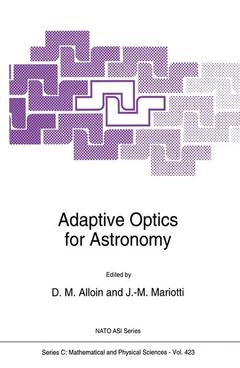Adaptive Optics for Astronomy, Softcover reprint of hardcover 1st ed. 1994 Nato Science Series C: Series, Vol. 423
Langue : Anglais
Coordonnateurs : Alloin D.M., Mariotti Jean-Marie

For many astronomers, Adaptive Optics is something like a dream coming true. Sinee 1609 and the first observations of celestial bodies performed with the help of an optieal teleseope, astronomers have always fighted to improve the 'resolving power' of their instruments. For a long time, engineers have trimmed the optieal quality of the teleseopes, until they finally reaehed the barrier set by the atmospherie turbulence, a few seconds of are. At that point, the intrinsic quality of the site beeame a major issue to establish new observatories with modern telescopes, and astronomers started to desert the urban skies and to migrate toward mountains and deserts. This quest has been sueeessful and a few privileged sites, where the average natural 'seeing' is close to 0. 5", are now hosting clusters of giant telescopes of the 4 m and soon 10 m class. Yet, this atmospherie limit corresponds in the visible wavelength range to the diffraetion limit of a 20 em telescope only. The loss was severe: a faetor 20 in angular and several hundred in peak energy eoncentration, i. e. in deteetivity of resolution very faint objeets. In the beginning of the seventies, two doors half opened to provide a way out of this dead-end. First, the technique of speckle interferometry (and its various related developments) has allowed to restore the diffraetion limit of large telescopes at visible and infrared wavelengths (see, e. g.
Preface. Part I: The Problematics of Adaptive Optics. Introduction to Wave Optics; C.A. Haniff. Atmospheric Turbulence Optical Effects: Understanding the Adaptive Optics Implications; D.L. Fried. Atmospheric Adaptive Optics Applications; V.P. Lukin. Modelling Atmospheric Turbulence Effects on Ground-Based Telescope Systems; L.W. Bradford, S.M. Flatté, C.E. Max. Servo-Loop Analysis for Adaptive Optics; M. Demerlé, P.Y. Madec, G. Rousset. The Problematics of Adaptive Optics Design; F. Roddier. Part II: Critical Components and Systems. Wavefront Sensing; G. Rousset. Optimization of Wavefront Sensors for the Highest Accuracy and Sensitivity; J.R.P. Angel. Deformable Mirrors; E.N. Ribak. Astronomical Reference Sources; F. Rigaut. Sodium-Layer Laser Guide Stars; H.W. Friedman. Synthetic Beacons for Atmospheric Compensation; D.P. Greenwood, R.R. Parenti. Sodium Beacon Used for Adaptive Optics on the Multiple Mirror Telescope; B.J. Carter, et al. Evaluating the Performance of Adaptive Optical Telescopes; B.M. Welsh, M.C. Roggemann. Integrated Adaptive Optics Systems; E.H. Richardson. Stray Radiation Issues in Astronomical Systems with Adaptive Optics; S.M. Pompea. Active Compensation of Global Wavefront Tilts; E. Ballesteros, T. Viera, F. Lorenzo, M. Reyes, J.A. Bonet, C. Martin. Part III: Astrophysics with Adaptive Optics. The Impact of Adaptive Optics on Focal Plane Instrumentation; S.T. Ridgway. Prospects for Alternative Approaches to Adaptive Optics; A.H. Greenaway. Adaptive Optics for Long Baseline Optical Interferometry; J.-M. Mariotti. Astrophysics with Adaptive Optics: Results and Challenges; P. Léna.Index.
Date de parution : 12-2010
Ouvrage de 338 p.
15.5x23.5 cm
Thème d’Adaptive Optics for Astronomy :
Mots-clés :
© 2024 LAVOISIER S.A.S.
